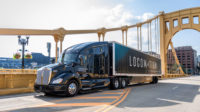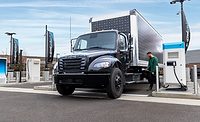Distribution
The road ahead for autonomous delivery trucks
Investments by truck manufacturers teases autonomous’ potential

Image courtesy of Daimler Truck AG
It was seven years ago this month that Anheuser-Busch carried 2,000 cases of Budweiser 120 miles from Fort Collins to Colorado Springs, Colo., via Otto, an Uber-owned self-driving vehicle company. Flash-forward to today and the prospect for widespread deployment of autonomous beverage delivery trucks is still very much a futuristic one. But there have been significant developments in the past couple of years that bring that future a little bit closer.
In August, self-driving truck company Kodiak Robotics unveiled its first East Coast truckport in Villa Rica, Ga. Kodiak says the facility will be an important hub for launching and landing the company’s autonomous trucks and serves as a convenient destination for drivers handling first- and last-mile deliveries. The site provides such services as refueling, light maintenance and pre-trip inspection, including enhanced inspections — which ensure safety and reliability.
The Georgia truckport extends Kodiak’s reach across the Dallas-to-Atlanta corridor. Its Dallas-Fort Worth hub will continue to serve as the main terminal for Kodiak’s autonomous truck fleet.
Earlier this year, Volvo Autonomous Solutions expanded its footprint in North America with the establishment of an office in Texas. The Fort Worth location is dedicated to driving activities to set up its first autonomous freight corridors that will run from Dallas-Fort Worth to El Paso and Dallas to Houston. Volvo Autonomous Solutions also has partnered with self-driving technology company Aurora, aimed at integrating the Aurora Driver with Volvo’s on-highway truck offering.
In March, Torc Robotics, an independent autonomous vehicle subsidiary of Daimler Truck AG announced that it was acquiring artificial intelligence startup Algolux Inc., gaining access to Algolux’s intellectual property and expertise in the areas of computer vision and machine learning. Daimler is entering its fifth year of partnership with Torc, all part of the company’s plan to commercialize its autonomous-ready Freightliner Cascadia.
At the end of 2021, the company announced that it was developing a scalable autonomous truck platform suited for SAE (Society of Automotive Engineers) Level 4 autonomous driving. Level 4 of the six levels of vehicle autonomy (which begin at Level 0 — no driving automation) entails “high driving automation,” which means that the autonomous vehicle systems are completely responsible for all driving and navigation. No driver interaction is necessary, but a driver can override the system manually if they so choose. Level 5, the highest level, is “full driving automation.” In most cases there’s no human involved and there may not even be a steering wheel.
The Daimler model would include redundancy systems necessary to achieve safe and reliable operations. There are four key areas with redundant architecture: the braking system, the steering system, the low-voltage power net and the network communications. If any of those systems encounter a fault, the vehicle would be able to monitor, assess and deploy backup systems to control the vehicle safely.
In 2019, Daimler established the Autonomous Technology Group, which is responsible for the overall strategy and implementation of the automated driving roadmap, including R&D, testing and validation and setting up the necessary infrastructure and vehicle network — with an eye toward commercializing the autonomous Cascadia within the current decade.
Currently, trucks with high levels of automation legally have limited areas on which to operate. Check back in a few years when that scenario very well may have changed.
“The future is now” is kind of a cliché and not entirely accurate. However, it’s undeniable that the future is…quite soon.
Looking for a reprint of this article?
From high-res PDFs to custom plaques, order your copy today!







